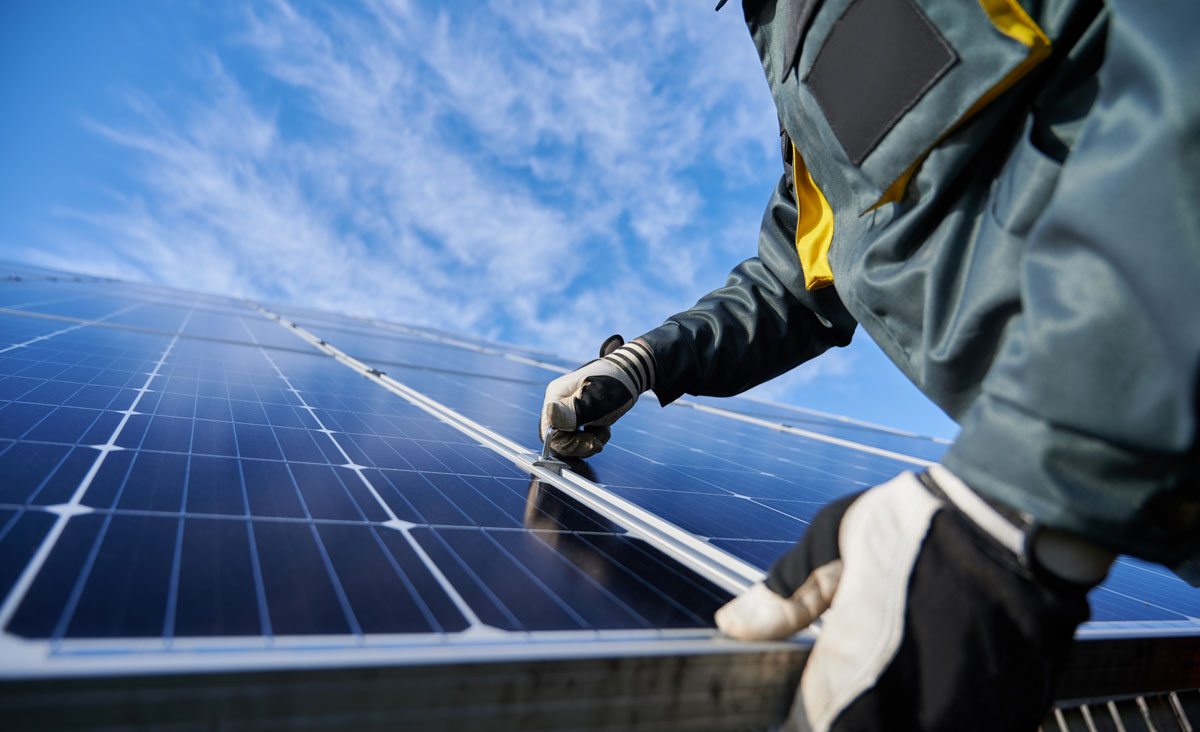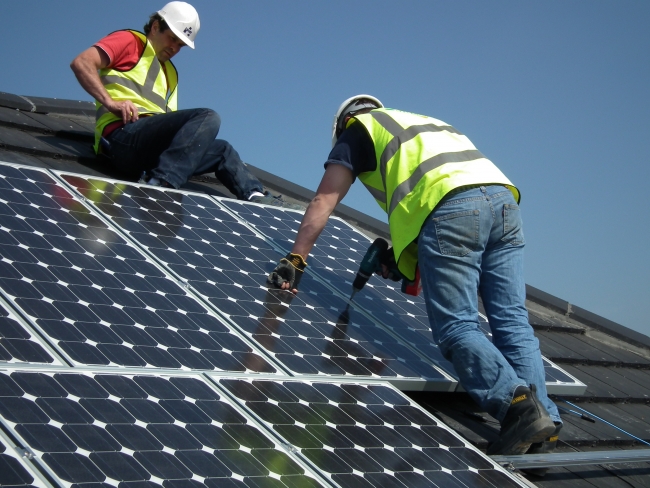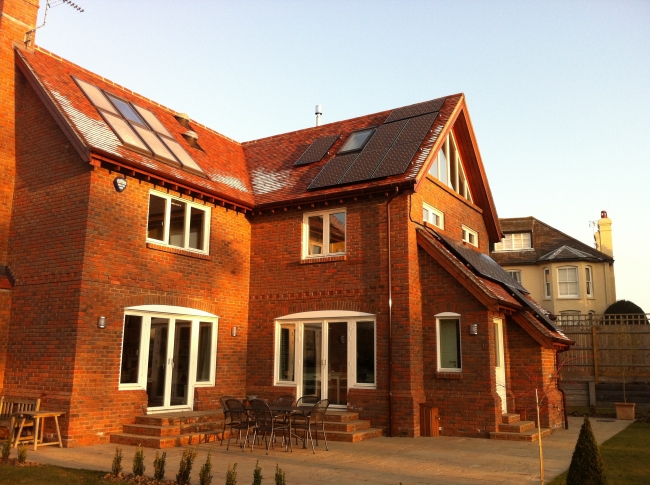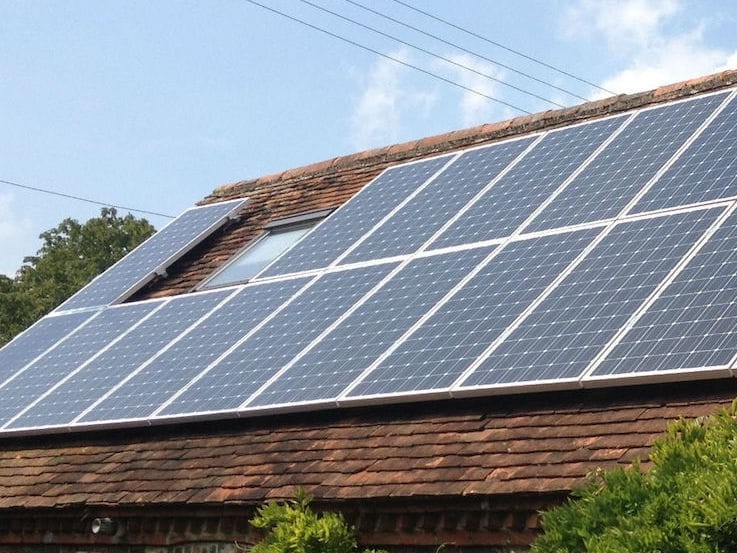Solar Battery Storage: Tesla Powerwall vs Sunpower Reserve vs Solaredge

Solar Battery Storage: Tesla Powerwall vs Sunpower Reserve vs Solaredge
Solar battery storage puts you in control of your power. More homeowners now understand this – recent data shows 43% of solar panel owners have installed battery systems alongside their panels. The numbers make sense. Most homes use between 8kWh and 10kWh of electricity daily, making battery storage essential for true energy independence.
Tesla Powerwall, Sunpower Reserve, and SolarEdge lead the market in home battery solutions. Each system brings its own strengths to your property. Tesla Powerwall 3 offers substantial storage with 13.5kWh usable capacity. SolarEdge Home Battery stands apart through unlimited cycle warranty and remarkable efficiency rates. System costs typically range from £2,000 to £7,500 – a significant investment that demands careful consideration.
Your choice of battery storage affects how you generate, store and use power at home. We’ll examine these three systems in detail – from technical capabilities to real-world performance. Whether you’re looking to maximise solar energy or secure backup power during outages, understanding these differences helps you choose the right solution for your needs.
Solar Battery Storage: Technical Details That Matter
The right battery storage system puts you in control of your power usage. Based on our experience, three key factors determine how well a battery system serves your home: storage capacity, power output, and system efficiency.
Storage Capacity: How Much Power Can You Store?
Tesla Powerwall keeps things simple. The Powerwall 3 offer 13.5 kWh usable capacity. Need more storage? Add up to 10 Powerwall units for a total of 135 kWh – enough to power multiple homes.
Sunpower Reserve takes a different path. Their modular design provides between 4.0kWh to 39 kWh of storage. Each 4.0 kWh module fits into the main enclosure, making future upgrades straightforward without replacing your whole system.
SolarEdge Home Battery starts at 10 kWh per unit. Stack up to three batteries together and you’ll have 30 kWh at your disposal. This creates a middle ground between Tesla’s larger steps and Sunpower’s flexible approach.
Most UK homes use 8-10 kWh daily. Even a single unit from any of these systems could power your essential needs for a full day. Your actual coverage depends on how you use power throughout the day.
Power Output: Running Your Appliances
Power output tells you how many appliances you can run at once. Tesla Powerwall 3 leads here with 11.5 kW continuous output – more than double the Powerwall 2’s capability. This means you can power heat pumps and charge electric vehicles while running your usual household devices.
SolarEdge offers 5 kW continuous power, with brief bursts up to 7.5 kW for 10 seconds. This handles most household needs, including startup surges from larger appliances. Sunpower Reserve matches typical industry standards, though they don’t prominently feature specific power ratings.
Efficiency and Battery Life
Both Tesla Powerwall 3 and SolarEdge Home Battery let you use 100% of their stated capacity – a significant advantage over older systems that limited access to 50-80% of total storage.
SolarEdge achieves 94.5% round-trip efficiency, while Tesla Powerwall 3 starts at 89% but can reach 97.5% in ideal conditions with DC coupling. Higher efficiency means less wasted power and lower electricity bills.
Warranty and Lifespan
Tesla leads with their 10-year unlimited cycle warranty, promising 80% capacity retention – better than the industry standard 70%. SolarEdge and Sunpower both offer 10-year warranties with 70% capacity guarantees.
Premium lithium batteries typically last 10-12 years. Since solar panels work for 25-30 years, plan on replacing your battery at least once during your solar system’s lifetime.
Tesla’s switch to Lithium Ferro Phosphate in Powerwall 3 promises longer life and better sustainability than the olderNickel Manganese Cobalt chemistry.
| Feature | Tesla Powerwall 3 | Sunpower Reserve | SolarEdge Home Battery |
| Usable Capacity | 13.5 kWh | 4.0-60 kWh | 10 kWh |
| Maximum System Size | Up to 135 kWh (10 units) | Up to 60 kWh | Up to 30 kWh (3 units) |
| Continuous Power | 11.5 kW | Industry standard | 5 kW |
| Peak Power | Higher than continuous | Industry standard | 7.5 kW (10 seconds) |
| Depth of Discharge | 100% | Industry standard | 100% |
| Round-Trip Efficiency | 89% (up to 97.5%) | Industry standard | 94.50% |
| Warranty Period | 10 years | 10 years | 10 years |
| End-of-Warranty Capacity | 80% | 70% | 70% |
| Cycle Limitations | Unlimited | Unlimited | Unlimited |
Your choice depends on more than just numbers. Installation requirements, system compatibility, and available space
all play crucial roles. We’ll help you understand these factors to find the perfect fit for your home.
Solar Battery Storage: Installation and System Compatibility
Battery storage installation needs careful planning. Our experience shows three key factors affect your system’s performance: how it connects to your solar panels, compatibility with existing equipment, and where you place it. Let’s look at what matters most when installing Tesla Powerwall, Sunpower Reserve, and SolarEdge systems.
Connecting Your Battery: AC vs DC Options
Your battery’s connection method affects both efficiency and performance. You have two choices: AC (Alternating Current) or DC (Direct Current).
DC-coupled systems connect straight to your solar panels before the generation meter. This direct connection means better efficiency – up to 98% compared to 90-94% for AC systems. You’ll also save money with just one inverter needed. Plus, DC systems handle extra power better. When your panels produce more than the inverter rating, that excess power charges your batteries instead of going to waste.
AC-coupled batteries work differently. They connect after your generation meter and need an AC/DC unit to convert power between your panels, home, and battery. Though slightly less efficient, AC systems offer key benefits:
- Easy to add to existing solar setups
- Can charge from both solar and grid power
- Keep your feed-in tariff payments unchanged
- Work with any inverter type
Tesla Powerwall 3 uses AC coupling, making it work with any solar system. SolarEdge gives you both options – their DC-coupled battery reaches 94.5% efficiency.
Adding Batteries to Your Current Solar Setup
Already have solar panels? You’ve got options. AC-coupled batteries like Tesla Powerwall offer the simplest solution. They work with both new and existing systems without changing your Feed-in Tariff setup.
DC-coupled batteries need more work to install. They suit new builds better than retrofits. But if you have a SolarEdge inverter, you can choose:
- Tesla Powerwall with SolarEdge StorEdge
- SolarEdge’s own battery for seamless integration
For microinverter systems like Enphase or SunPower, stick with AC-coupled batteries. Microinverters actually work better with batteries during partial shade – even one sunny panel keeps generating power.
Remember to check with your utility company about updating agreements and notify your local Distribution Network Operator about your storage system.
Space and Mounting: Getting the Fit Right
Each system needs specific space for proper operation. Take Tesla Powerwall:
- Side-to-side: 38 inches (960 mm)
- Left side (air intake): 2 inches (50 mm)
- Right side (air exhaust): 6 inches (150 mm)
- Above unit: 2 inches (50 mm)
- Height from ground: max 39.5 inches (1 m)
Leave 8 inches (200 mm) working space on the left for wiring. Multiple Powerwalls need 10 inches (250 mm) between units.
Think about noise too. Tesla Powerwall runs with a gentle hum like a fridge. This might affect where you put it, especially indoors.
Choose between indoor and outdoor mounting:
Indoor installation (garages, utility rooms, basements):
- Protects from weather
- Keeps steady temperature
- Needs dedicated space
Outdoor installation:
- Works well with limited indoor space
- Needs sun protection
- Must handle weather conditions
All three manufacturers offer weatherproof designs. For backup power, you can choose which circuits to protect. Tesla Powerwall 3 lets you separate backup and non-backup loads.
Want to expand later? Each system offers different options:
- Tesla Powerwall: Up to 10 units, each adding 7.6kW solar capacity for outages
- SolarEdge: Stack up to three batteries
- Sunpower Reserve: Add modules within their enclosure
Professional installation ensures everything works right. We’ll help size your system correctly and plan for future needs. The right setup today saves headaches tomorrow.
Smart Features and Energy Control
Smart technology puts you in control of your power. Since 2010, we’ve helped customers understand and manage their energy through sophisticated monitoring systems. Tesla Powerwall, SolarEdge, and Sunpower Reserve each offer unique ways to control your power usage.
Mobile Apps: Your Energy Command Center
Tesla’s app shows exactly how power flows through your home. Watch energy move from solar panels to battery storage or see how much grid power you’re using. Check daily, weekly, or monthly patterns to optimise your energy use. Download your data for deeper analysis.
SolarEdge takes a different approach. Their mysolaredge app lets you control smart home devices directly. During power shortages, you choose which appliances get priority. Both systems watch the weather too – Tesla’s Storm Watch fills your Powerwall before storms hit, while SolarEdge adjusts to weather patterns for maximum savings.
Do you want to see where your power goes? These apps transform how you think about energy. One of our customers said it best: “There’s something special about producing your own power… you’re not a slave to your local electric utility anymore.”
| Feature | Tesla Powerwall | SolarEdge | SunPower Reserve |
| Real-time monitoring | Comprehensive home energy view | Power flow illustrations and charts | Standard monitoring capabilities |
| Historical data | Complete access to all historical data | Comparative analysis tools | Basic historical reporting |
| Special modes | Smart Watch, Self-Powered, Time-Based Control | Smart mode for rate optimisation | Standard operating modes |
| Device control | EV charging optimisation | Direct control of smart home devices | Basic battery control |
| Data export | Direct from app | Available | Limited |
Backup Power: Keep Your Lights On
Power cuts happen. But with modern battery systems, you might not even notice. Tesla Powerwall switches to battery power within milliseconds. Your lights stay on, your fridge keeps running, and your life continues uninterrupted.
How much backup power do you need? We help customers choose between two approaches:
- Essential circuits only – Keeps critical systems running longer
- Whole-home backup – Powers everything but needs more batteries
A standard battery system runs selected circuits for 6-9 hours without solar charging. With working solar panels, your backup power could last indefinitely. Both Tesla and SolarEdge let you test backup modes before real outages hit.
Smart panels give you even more control. Unlike fixed backup systems, smart panels let you choose which devices get power during outages. Change priorities through your phone instead of deciding once during installation.
Virtual Power Plants: The Future of Energy
Virtual Power Plants (VPPs) change how we think about electricity. Instead of relying on big power stations, grid operators tap into thousands of home batteries working together. This creates new opportunities for battery owners.
We’ve seen growing interest in VPP programs. Tesla’s Time-Based Control charges your Powerwall when rates are low and sells power back when prices peak. SolarEdge does similar smart trading, watching electricity rates and solar production to maximise your savings.
The benefits work both ways. You earn money selling power back to the grid, while VPP participation helps your battery last longer. Some programs even offer free or discounted batteries if you join their VPP network.
Electric vehicles add another dimension. With batteries ten times larger than home systems, EVs could dramatically expand VPP impact. One company already launched a program letting EVs power homes and support the grid.
Based on our experience, smart features transform how you use energy. Whether you want detailed power monitoring, reliable backup, or income from grid services, today’s battery systems put you in control.
Battery System Specifications Compared
Based on our experience installing solar battery systems since 2010, these specifications determine how well each system serves your needs. We’ve carefully handpicked the most effective technology on the market, and this comparison shows why these three systems lead the industry.
| Feature | Tesla Powerwall 3 | Sunpower Reserve | SolarEdge Home Battery |
| Usable Capacity | 13.5 kWh | 4-60 kWh | 10 kWh |
| Maximum System Size | 135 kWh (10 units) | 60 kWh | 30 kWh (3 units) |
| Continuous Power Output | 11.5 kW | Not specified | 5 kW |
| Peak Power Output | Not specified | Not specified | 7.5 kW (10 seconds) |
| Round-Trip Efficiency | 89 % (up to 97.5 % DC-coupled) | Industry standard (85–95 %) | 94.5 % |
| Depth of Discharge | 100 % | Not specified | 100 % |
| Warranty Period | 10 years | 10 years | 10 years |
| End-of-Warranty Capacity | 80 % | 70 % | 70 % |
| Cycle Warranty | Unlimited | Unlimited | Unlimited |
| Battery Chemistry | Lithium Ferro Phosphate (LFP) | Not specified | Not specified |
| Mobile App Features | Real-time monitoring, Storm Watch, historical data | Standard monitoring | Power flow illustrations, smart device control |
| Grid Services | VPP participation, Time-Based Control | VPP participation | Smart optimisation, rate management |
| Coupling Options | AC-coupled | Not specified | AC and DC-coupled options |
Tesla Powerwall 3 stands out with its high continuous power output – more than double what SolarEdge offers. You’ll power more appliances simultaneously, from heat pumps to electric vehicle chargers. Plus, Tesla’s 80% end-of-warranty capacity guarantee exceeds the industry standard 70%.
Sunpower Reserve shines in flexibility. Their modular design scales from 4 kWh to 60 kWh, perfect if you’re starting small but planning to expand. Each 4 Wh module fits neatly within their enclosure system.
SolarEdge takes efficiency seriously. Their 94.5% round-trip efficiency means less wasted power, especially with DC coupling. Though starting at 10 kWh capacity, you can stack up to three units for whole-home coverage.
Whether you need solar PV for your business or a battery storage system to save on energy bills, these specifications help match the right system to your needs. Take a look at our work across the region – we’ve likely been in a postcode near you before.
The Right Battery Storage Choice for Your Home
Since 2010, we’ve helped customers find the best way to reduce their carbon footprint through solar battery storage. Do you want reliable backup power? Tesla Powerwall 3 delivers 11.5 kW continuous output – enough for your whole home. Looking for room to grow? Sunpower Reserve’s modular design expands to kWh. Need maximum efficiency? SolarEdge converts 94.5% of stored power back to usable energy.
The technology and tariffs available put property owners and businesses in the driving seat of their energy usage. Tesla Powerwall suits homes needing substantial backup power. Sunpower Reserve works best when you want to start small and expand later. SolarEdge fits perfectly with existing solar systems, especially if efficiency matters most.
Mobile apps show exactly where your power goes – from solar panels to battery to home. Virtual power plants let you earn money selling excess energy back to the grid. Whether you need solar PV for your business or battery storage to save on energy bills, we can help.
Take a look at our work across the region. We’ve likely been in a postcode near you before. The Little Green Energy Company is thrilled to be part of a movement dedicated to tackling climate change head-on. Be a part of the change by reducing your dependence on the grid and lowering your carbon footprint.
Ready to explore battery storage for your property? Talk to our team about claiming your energy independence.
FAQs
Q1. How do Tesla Powerwall, Sunpower Reserve, and SolarEdge Home Battery compare in terms of capacity? Tesla Powerwall offers 13.5 kWh of usable capacity, Sunpower Reserve provides 4 – 60 Wh, and SolarEdge Home Battery has 10 Wh per unit. Tesla and SolarEdge allow for multiple unit installations, while Sunpower’s modular design offers built-in expandability.
Q2. What are the key differences in power output between these battery systems? Tesla Powerwall 3 leads with 11.5 kW continuous power output. SolarEdge Home Battery provides 5 kW continuous and 7.5 kW peak power for up to 10 seconds. Sunpower Reserve’s specific output is not prominently featured but aligns with industry averages for its size class.
Q3. How do these battery systems handle grid outages? All three systems offer backup power capabilities during outages. They can switch to battery power quickly, often within milliseconds. The duration of backup power depends on the battery capacity and whether solar panels can continue charging the battery during the outage.
Q4. What smart features do these battery systems offer? These systems come with mobile apps for real-time monitoring and control. Tesla’s app provides comprehensive energy flow visualisation and historical data. SolarEdge offers smart home device control and optimisation based on consumption patterns and electricity rates. All systems can participate in grid services and virtual power plants.
Q5. How do warranty and lifespan compare between these battery options? All three systems offer 10-year warranties with unlimited cycles. Tesla Powerwall 3 guarantees 80% capacity retention by the end of the warranty period, while Sunpower Reserve and SolarEdge promise 70%. The typical lifespan of these premium lithium-ion batteries ranges from 10-12 years.


